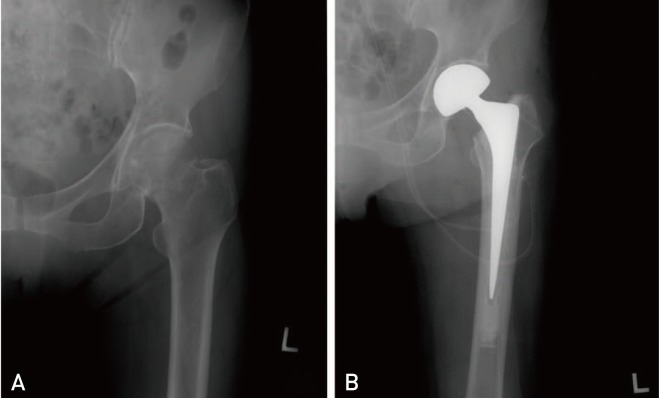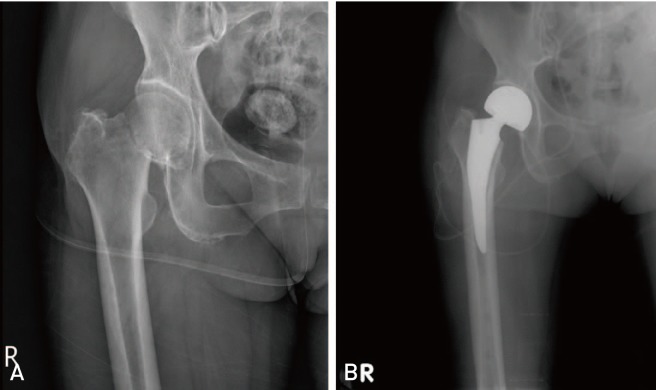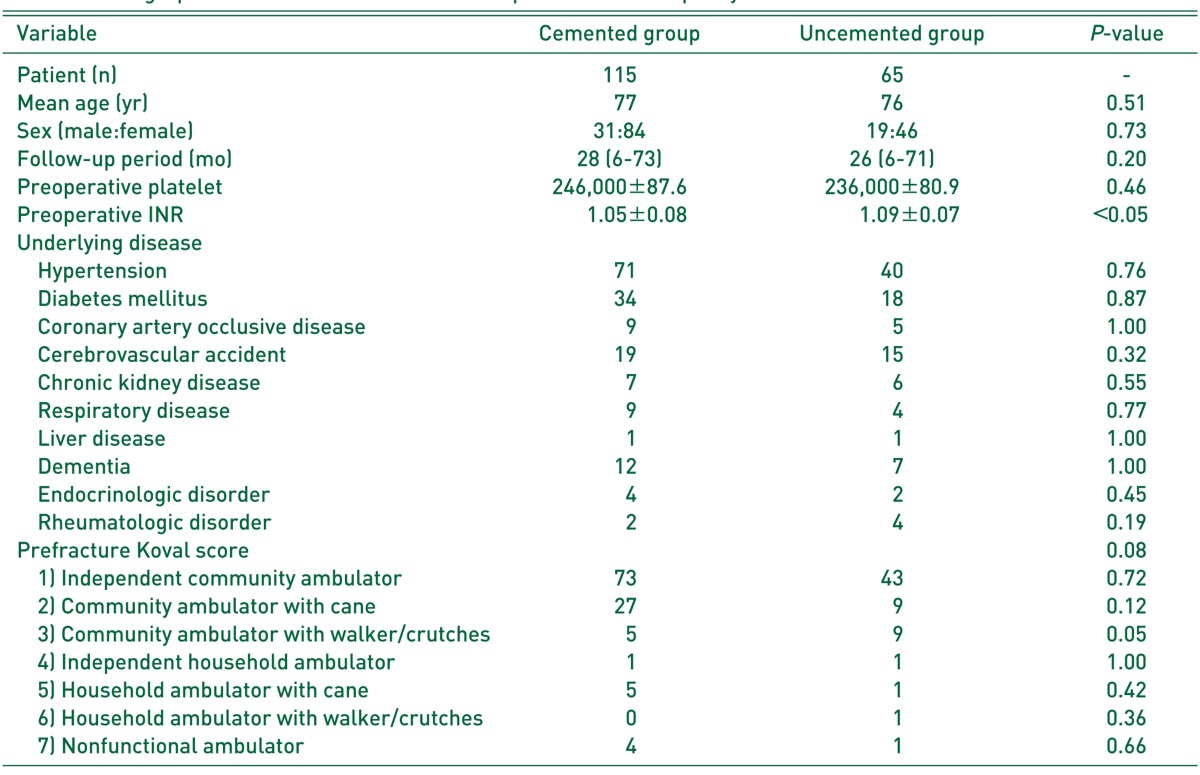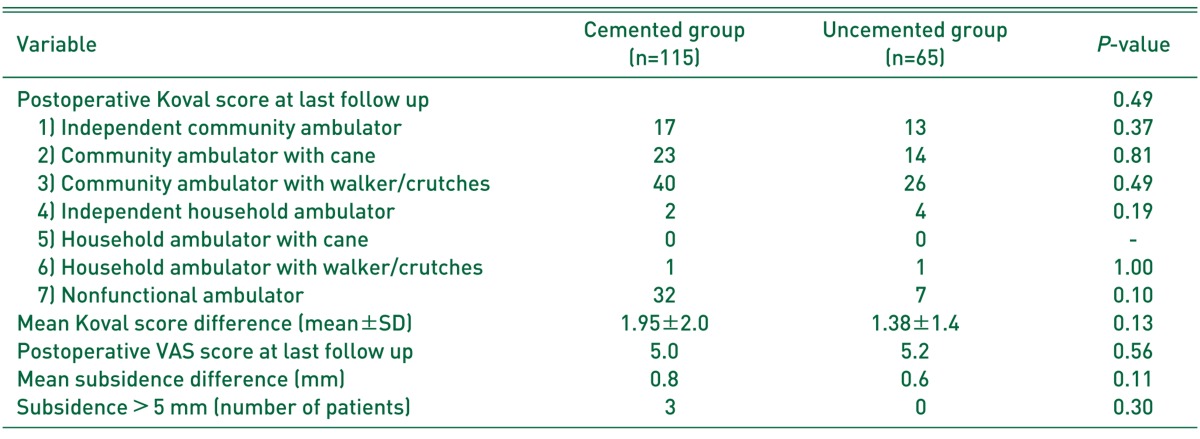1. Bhandari M, Devereaux PJ, Tornetta P 3rd, et al. Operative management of displaced femoral neck fractures in elderly patients. An international survey. J Bone Joint Surg Am. 2005; 87:2122–2130. PMID:
16140828.
2. Branco JC, Felicíssimo P, Monteiro J. Epidemiology of hip fractures and its social and economic impact. A revision of severe osteoporosis current standard of care. Acta Reumatol Port. 2009; 34:475–485. PMID:
19820671.
3. Cuckler JM, Tamarapalli JR. An algorithm for the management of femoral neck fractures. Orthopedics. 1994; 17:789–792. PMID:
7800601.

4. Dhanwal DK, Dennison EM, Harvey NC, Cooper C. Epidemiology of hip fracture: Worldwide geographic variation. Indian J Orthop. 2011; 45:15–22. PMID:
21221218.

5. Frihagen F, Nordsletten L, Madsen JE. Hemiarthroplasty or internal fixation for intracapsular displaced femoral neck fractures: randomised controlled trial. BMJ. 2007; 335:1251–1254. PMID:
18056740.

6. Parker MJ, Gurusamy K. Internal fixation versus arthroplasty for intracapsular proximal femoral fractures in adults. Cochrane Database Syst Rev. 2006; (4):CD001708. PMID:
17054139.

7. Emery RJ, Broughton NS, Desai K, Bulstrode CJ, Thomas TL. Bipolar hemiarthroplasty for subcapital fracture of the femoral neck. A prospective randomised trial of cemented Thompson and uncemented Moore stems. J Bone Joint Surg Br. 1991; 73:322–324. PMID:
2005165.

8. Fallon KM, Fuller JG, Morley-Forster P. Fat embolization and fatal cardiac arrest during hip arthroplasty with methylmethacrylate. Can J Anaesth. 2001; 48:626–629. PMID:
11495867.

9. Foster AP, Thompson NW, Wong J, Charlwood AP. Periprosthetic femoral fractures--a comparison between cemented and uncemented hemiarthroplasties. Injury. 2005; 36:424–429. PMID:
15710161.
10. Khan RJ, MacDowell A, Crossman P, et al. Cemented or uncemented hemiarthroplasty for displaced intracapsular femoral neck fractures. Int Orthop. 2002; 26:229–232. PMID:
12185525.

11. Lennox IA, McLauchlan J. Comparing the mortality and morbidity of cemented and uncemented hemiarthroplasties. Injury. 1993; 24:185–186. PMID:
8509191.

12. Lo WH, Chen WM, Huang CK, Chen TH, Chiu FY, Chen CM. Bateman bipolar hemiarthroplasty for displaced intracapsular femoral neck fractures. Uncemented versus cemented. Clin Orthop Relat Res. 1994; (302):75–82.

13. Skyrme AD, Jeer PJ, Berry J, Lewis SG, Compson JP. Intravenous polymethyl methacrylate after cemented hemiarthroplasty of the hip. J Arthroplasty. 2001; 16:521–523. PMID:
11402421.

14. Baker RP, Squires B, Gargan MF, Bannister GC. Total hip arthroplasty and hemiarthroplasty in mobile, independent patients with a displaced intracapsular fracture of the femoral neck. A randomized, controlled trial. J Bone Joint Surg Am. 2006; 88:2583–2589. PMID:
17142407.
15. Keating JF, Grant A, Masson M, Scott NW, Forbes JF. Randomized comparison of reduction and fixation, bipolar hemiarthroplasty, and total hip arthroplasty. Treatment of displaced intracapsular hip fractures in healthy older patients. J Bone Joint Surg Am. 2006; 88:249–260. PMID:
16452734.
16. Dorr LD, Faugere MC, Mackel AM, Gruen TA, Bognar B, Malluche HH. Structural and cellular assessment of bone quality of proximal femur. Bone. 1993; 14:231–242. PMID:
8363862.

17. Nash W, Harris A. The Dorr type and cortical thickness index of the proximal femur for predicting peri-operative complications during hemiarthroplasty. J Orthop Surg (Hong Kong). 2014; 22:92–95. PMID:
24781623.

18. Johnston RC, Fitzgerald RH Jr, Harris WH, Poss R, Müller ME, Sledge CB. Clinical and radiographic evaluation of total hip replacement. A standard system of terminology for reporting results. J Bone Joint Surg Am. 1990; 72:161–168. PMID:
2303502.

19. Pitto RP, Koessler M, Kuehle JW. Comparison of fixation of the femoral component without cement and fixation with use of a bone-vacuum cementing technique for the prevention of fat embolism during total hip arthroplasty. A prospective, randomized clinical trial. J Bone Joint Surg Am. 1999; 81:831–843. PMID:
10391548.

20. Li T, Zhuang Q, Weng X, Zhou L, Bian Y. Cemented versus uncemented hemiarthroplasty for femoral neck fractures in elderly patients: a meta-analysis. PLoS One. 2013; 8:e68903. PMID:
23935902.

21. Luo X, He S, Li Z, Huang D. Systematic review of cemented versus uncemented hemiarthroplasty for displaced femoral neck fractures in older patients. Arch Orthop Trauma Surg. 2012; 132:455–463. PMID:
22160512.

22. Ng ZD, Krishna L. Cemented versus cementless hemiarthroplasty for femoral neck fractures in the elderly. J Orthop Surg (Hong Kong). 2014; 22:186–189. PMID:
25163952.

23. Taylor F, Wright M, Zhu M. Hemiarthroplasty of the hip with and without cement: a randomized clinical trial. J Bone Joint Surg Am. 2012; 94:577–583. PMID:
22488613.

24. Parvizi J, Heller S, Berend KR, Della Valle CJ, Springer BD. Periprosthetic joint infection: the algorithmic approach and emerging evidence. Instr Course Lect. 2015; 64:51–60. PMID:
25745894.
25. Bongartz T, Halligan CS, Osmon DR, et al. Incidence and risk factors of prosthetic joint infection after total hip or knee replacement in patients with rheumatoid arthritis. Arthritis Rheum. 2008; 59:1713–1720. PMID:
19035425.

26. Aggarwal VK, Tischler EH, Lautenbach C, et al. Mitigation and education. J Arthroplasty. 2014; 29(2 Suppl):19–25. PMID:
24360487.

27. Figved W, Opland V, Frihagen F, Jervidalo T, Madsen JE, Nordsletten L. Cemented versus uncemented hemiarthroplasty for displaced femoral neck fractures. Clin Orthop Relat Res. 2009; 467:2426–2435. PMID:
19130162.

28. Park SE, Kim YY, Jeong JJ, Choi SG, Jeong DS, Kim WY. Comparison of postoperative bleeding and complications between cemented and non-cemented bipolar hemiarthroplasty in treatment of unstable pertrochanteric fracture. Hip Pelvis. 2013; 25:37–43.








 PDF
PDF ePub
ePub Citation
Citation Print
Print




 XML Download
XML Download